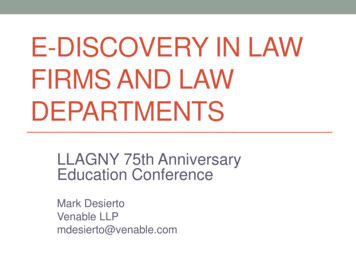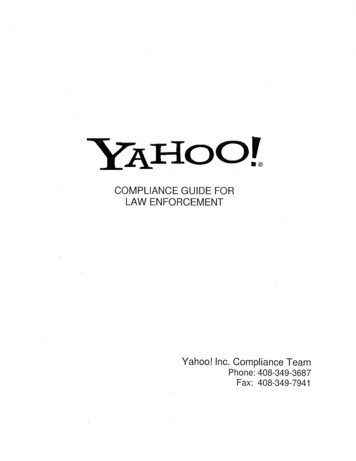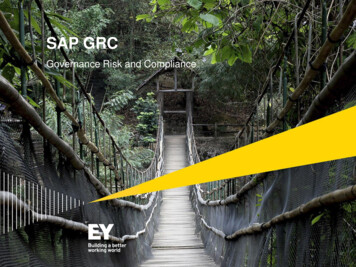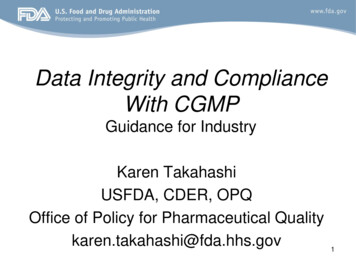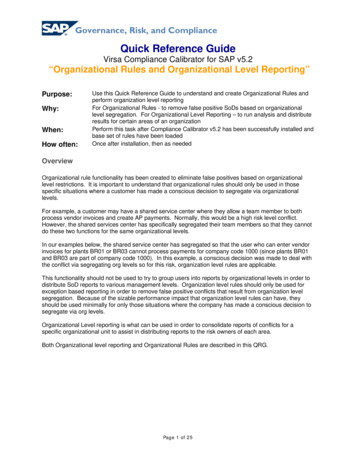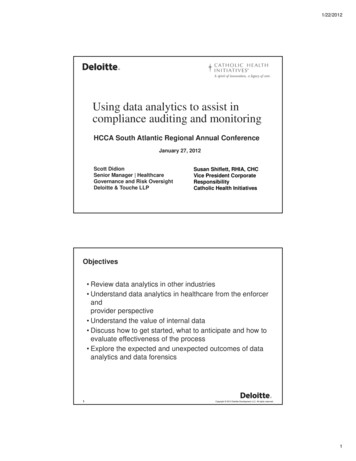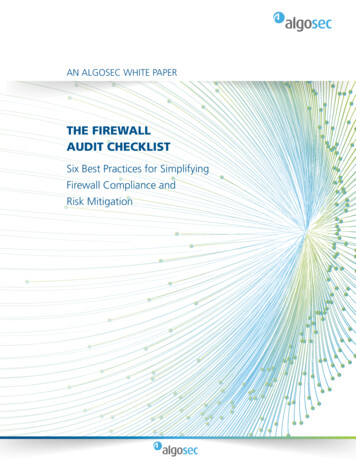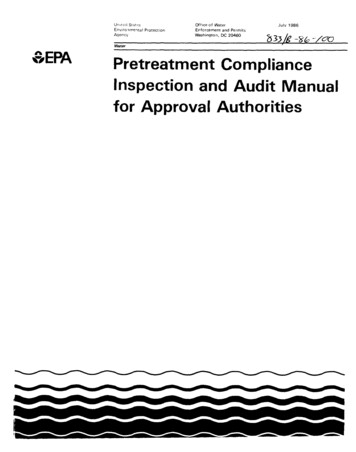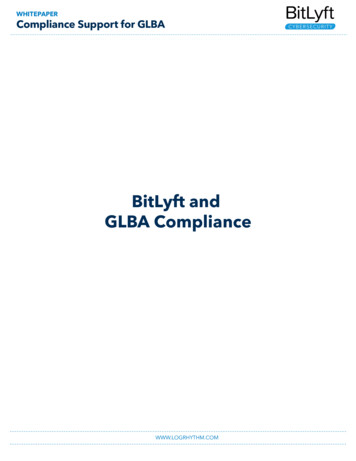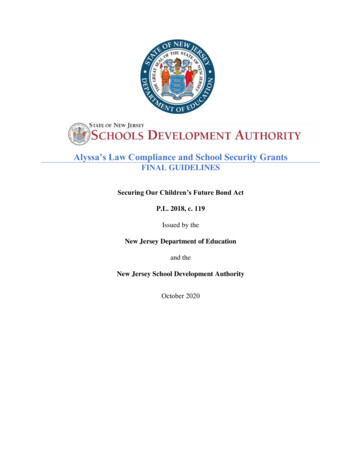
Transcription
Alyssa’s Law Compliance and School Security GrantsFINAL GUIDELINESSecuring Our Children’s Future Bond ActP.L. 2018, c. 119Issued by theNew Jersey Department of Educationand theNew Jersey School Development AuthorityOctober 2020
FINAL GUIDELINESAlyssa’s Law Compliance and School Security GrantsSecuring Our Children’s Future Bond ActTABLE OF CONTENTSIntroduction . 4Part A: Alyssa’s Law Compliance . 51. ALYSSA’S LAW COMPLIANCE CERTIFICATION GUIDELINES . 51.1Mandatory Certification of Compliance . 51.2Eligible Systems for Alyssa’s Law Compliance . 52. ALYSSA’S LAW COMPLIANCE CERTIFICATION PROCEDURES . 62.1Certification Format . 62.2EWEG System Considerations . 62.3Certification Timeline for School Security Grant Eligibility . 73. ALYSSA’S LAW COMPLIANCE SUBMISSION REQUIREMENTS . 73.1Evidence of Existing Compliance . 73.2Proposed Compliance Plan . 83.3Requirements for Leased Facilities . 8Part B: School Security Grant Guidelines . 101. GRANT PROGRAM OVERVIEW. 101.1Description of Grant Program . 101.2Summary of Key Considerations . 101.3Eligibility Criteria and Funding . 101.4Important Dates . 112. ELIGIBILITY REQUIREMENTS AND PROJECT GUIDELINES . 112.1Eligibility to Apply . 112.2Bond Act Requirements . 112.3N.J.S.A. 18A:7G-5.2 School Security Upgrades and Eligible Work for Grant Funding . 122.4Work Deemed Ineligible for Grant Funding . 133. APPLICATION PROCEDURES . 133.1Number of Permissible Applications . 133.2Application Format . 133.3EWEG System Considerations . 143.4Application Deadline . 144. APPLICATION COMPONENTS . 144.1General Considerations . 144.2Submission Checklist . 144.3Certification of Alyssa’s Law Compliance . 144.4N.J.S.A. 18A:7G-5.2 School Security Upgrades . 144.5Requirements for Leased Facilities . 154.6NJDOE Office of School Facilities Project Application and LRFP Amendment . 154.7A District Board of Education Resolution . 16Final Guidelines Alyssa’s Law Compliance and School Security GrantsPage 2 of 31
5. APPLICATION REVIEW AND AWARD INFORMATION . 165.1Eligibility Review . 165.2Maximum Allowance for Grant Funding . 165.3Revisions to Approved Applications . 176. GRANT AWARD ADMINISTRATION AND OTHER INFORMATION . 176.1Grant Agreement Offer Letter. 176.2Updates to Draft Application Guidelines . 176.3Questions. 17APPENDIX A: DISTRICT SECURITY GRANT ALLOWANCES . 18APPENDIX B: SCHOOL SECURITY GRANT APPLICATION CHECKLIST. 30Final Guidelines Alyssa’s Law Compliance and School Security GrantsPage 3 of 31
IntroductionThe New Jersey Department of Education (“NJDOE”), in consultation with the New Jersey SchoolsDevelopment Authority (“NJSDA”) for compliance with N.J.S.A. 18A:41-10 et seq. (“Alyssa’s Law”),is issuing these Final Guidelines to inform public school districts of the upcoming grant program toimprove school security as authorized by the Securing Our Children’s Future Bond Act, P.L. 2018, c.119(“Bond Act”).The Final Guidelines are organized into two sections: Part A explaining Alyssa’s Law compliance and certification activities overseen by the NJSDA;and Part B describing school security grant eligibility and submission requirements to be overseen bythe NJDOE.Final Guidelines Alyssa’s Law Compliance and School Security GrantsPage 4 of 31
Part A: Alyssa’s Law Compliance1. ALYSSA’S LAW COMPLIANCE CERTIFICATION GUIDELINES1.1 Mandatory Certification of ComplianceAlyssa’s Law requires each public elementary and secondary school building to be equipped withat least one panic alarm that is directly linked to local law enforcement authorities. (See SectionA1.2 of the Final Guidelines for the definition of a panic alarm and a description of suitablesystems.) All school districts are required to obtain certification of compliance withAlyssa’s Law regardless of whether or not the district intends to apply for a school securitygrant under the Bond Act.The NJSDA will be overseeing compliance. NJSDA’s regulations for Alyssa’s Law are noweffective and can be accessed here.In order to be eligible for school security grant funding under the Bond Act, districts must eitherdemonstrate compliance with Alyssa’s Law or submit a school security grant applicationrequesting funding to achieve compliance. After compliance is achieved and demonstrated in allschool buildings, the district’s school security grant allocation may be used for additional eligiblesecurity improvements as outlined in Section A2.3 of these Final Guidelines. Districts willdemonstrate and/or propose their plan for compliance in each school building by completingNJSDA’s Alyssa’s Law Compliance Determination Application, which will be accessed throughNJDOE Homeroom along with the school security grant application.Districts may obtain certification of Alyssa’s Law compliance from the NJSDA prior to orsimultaneous with the school security grant application period. However, the school securitygrant application system will not be available to districts that have not demonstratedcompliance or approved proposed compliance with Alyssa's Law through thatsystem.1.2 Eligible Systems for Alyssa’s Law ComplianceAlyssa’s Law requires all school buildings to be equipped with a panic alarm connected to locallaw enforcement. General requirements, as described in P.L. 2019, c.3, are as follows:C.18A:41-11 Equipping public and secondary schools with panic alarms or emergency mechanisms.2. a. As used in this section:“Panic alarm” means a silent security system signal generated by the manual activation of a deviceintended to signal a life-threatening or emergency situation requiring a response from lawenforcement.b. Except as otherwise provided pursuant to subsection e. of this section, each publicelementary and secondary school building shall be equipped with at least one panic alarm for use ina school security emergency including, but not limited to, a non-fire evacuation, lockdown, or activeshooter situation. The alarm shall be directly linked to local law enforcement authorities or, in thecase of a school building located in a municipality in which there is no municipal police department,a location designated by the Superintendent of State Police, and shall immediately transmit a signalor message to such authorities upon activation. The alarm shall not be audible within the schoolbuilding.c. Each panic alarm required under this section shall adhere to nationally recognized industrystandards, including the standards of the National Fire Protection Association and UnderwritersLaboratories.Final Guidelines Alyssa’s Law Compliance and School Security GrantsPage 5 of 31
d. Each panic alarm required under this section shall be installed solely by a person licensed toengage in the alarm business in accordance with the provisions of section 7 of P.L.1997, c.305(C.45:5A-27).Alyssa’s Law requirements can be satisfied in a variety of ways. Districts should implement themost responsive system in accordance with their School Security and Safety Plans and schoolbuilding configurations. Examples of systems that satisfy Alyssa’s Law requirements follow.Compliance may include one or a combination of systems. A district may also equip a schoolbuilding with an alternative emergency mechanism if approved by the NJDOE as meeting Alyssa’sLaw requirements.Examples of Systems to Address Alyssa’s Law Compliance Smart phone and computer applications Personal carry wireless activation devices One or more wireless panic button stations One or more wired panic button station(s), with optional supplemental wirelessstations and devices; and/or Integrated security system that includes wired panic alarms and personal carrywireless activation devices and/or smartphone and computer applications, accesscontrol, lockdown notification, security video, etc.Battery-operated systems must include low battery notification, and all systems should have abattery backup in case of a power failure. The panic alarm may be integrated with othercommunications and security systems. However, should a district elect to install a system thatexceeds the minimum requirements of Alyssa’s Law and the cost of such system exceeds thedistrict’s security grant allocation, any such excess cost must be paid with local funds.Districts may apply for retroactive reimbursement for costs incurred for Alyssa’s Law compliance,up to the district’s security grant allocation, if the eligible system was installed no earlier thanJanuary 1, 2016.2. ALYSSA’S LAW COMPLIANCE CERTIFICATION PROCEDURES2.1 Certification FormatDistricts may submit applications for Alyssa’s Law certification using the NJDOE’s onlineElectronic Web Enabled Grant (EWEG) system accessed through NJDOE Homeroom.Once the window for acceptance of school security grant applications opens, a district’s Alyssa’sLaw compliance information will be connected to the grant application system. The EWEGsystem will address all school security grant components and reporting requirements,including submissions to the NJSDA for certification of Alyssa’s Law compliance. Noduplicative submissions to the NJDOE are required. Detailed descriptions of the grant reportingrequirements are provided in Section B4 of these guidelines.2.2 EWEG System ConsiderationsFinal Guidelines Alyssa’s Law Compliance and School Security GrantsPage 6 of 31
Each district must have a login ID and password to access the EWEG system. Questions regardingaccess can be directed to the EWEG help email account.The responsibility for a timely submission resides with the applicant. Therefore, applicants shouldplan appropriately to allow time to address any technical challenges that may occur. The NJDOEstrongly advises applicants not to wait until the due date to submit the application on the EWEGsystem, since it may be slower than normal due to increased usage.2.3 Certification Timeline for School Security Grant EligibilityIn order to be eligible for a school security grant under the Bond Act, districts must eitherdemonstrate compliance with Alyssa’s Law or submit a school security grant applicationrequesting funding in order to achieve compliance. Only once compliance with Alyssa’s Law isachieved and demonstrated using the EWEG system can funding be utilized for eligible additionalsecurity improvements.Districts must demonstrate compliance or proposed compliance using the EWEG system to beeligible for grant funding, thus the grant application will not open to districts until Alyssa'sLaw compliance is demonstrated. The deadline for school security grant applications isNovember 20, 2020. See Section B1.4 for additional information.3. ALYSSA’S LAW COMPLIANCE SUBMISSION REQUIREMENTS3.1 Evidence of Existing ComplianceThe district must provide sufficient documentation for the NJSDA to certify existing compliancewith Alyssa’s Law. Required documentation for each school building include: The manufacturer’s description of the panic alarm system, or a brief description of thepanic alarm system, including the method of operation for signaling local law enforcementto demonstrate that the installation satisfies the requirements of Alyssa’s Law(N.J.S.A.18A:41-11a through d); If requesting approval for an existing installation that does not meet any provision ofAlyssa’s Law (N.J.S.A.18A:41-11a through d), a description of how the system meets thespirit and intent of Alyssa’s Law and why it should be approved as an alternativeemergency mechanism by the NJDOE; Photo or video evidence of the panic alarm installed in at least one location in the schoolbuilding; Completion of a certification (in a form provided by the NJSDA) by a law enforcementofficial with jurisdiction in the municipality in which the school building is located,confirming that the school building is equipped with a panic alarm that, upon activation,transmits a signal or message to the local municipal police department, or in the case of aschool building in a municipality without a local municipal police department, transmits asignal or message to a location designated by the Superintendent of State Police; and Detailed and dated invoices and proof of payment if requesting reimbursement for workcompleted on or after January 1, 2016.Final Guidelines Alyssa’s Law Compliance and School Security GrantsPage 7 of 31
It is highly recommended that districts take advantage of certifying existing compliance withAlyssa’s Law prior to the opening of the grant application period.3.2 Proposed Compliance PlanThe district must articulate a compliance plan and provide sufficient documentation to determinethe adequacy of the proposed plan for those buildings that do not comply with Alyssa’s Law.Required documentation for each school building include: The manufacturer’s description of the proposed panic alarm system, or a brief descriptionof the proposed panic alarm system, including the method of operation for signaling locallaw enforcement sufficient to demonstrate how the proposed installation will satisfy therequirements of Alyssa’s Law (N.J.S.A.18A:41-11a through d); If the district is proposing an installation that does not meet any provision of Alyssa’s Law(N.J.S.A.18A:41-11a through d), a description of how the proposed system meets the spiritand intent of Alyssa’s Law and why it should be approved as an alternative emergencymechanism by the NJDOE; A detailed cost estimate by a vendor or design professional for the proposed work; A written acknowledgment by the chief school administrator, school businessadministrator, or designee, affirming that the proposed installer meets licenserequirements,1 or that provides a description of the proposed installer’s credentials; Certification (in a form provided by the Commissioner) that the proposed panic alarmsystem will connect to and upon activation notify local law enforcement or, in the case ofa school building located in a municipality in which there is no municipal policedepartment, a location designated by the Superintendent of State Police. The certificationshall be signed by the chief school administrator, school business administrator, ordesignee, the licensed installer, or a school district architect or other design consultant whodesigned the panic alarm system; and The anticipated installation completion date.Please note that the SDA will validate compliance after completion of the proposed work.Districts will be required to submit additional documentation in the EWEG system inaccordance with Section A3.1 of the Final Guidelines after all school buildings achievecompliance.3.3 Requirements for Leased FacilitiesIf grant funding is being requested for a leased facility, the applicant must also submit: The lease agreement and/or a Memorandum of Understanding (MOU) pending theexecution of a lease agreement or a lease agreement addendum that stipulates (1) thelessor is a public entity, such as a school district or county college, (2) the is for no less1The alarm must be installed by a person licensed to engage in the alarm business in accordance with theprovisions of section 7 of P.L.1997, c. 305 (C.45:5A–27), or the system must be approved as an alternativeemergency mechanism.Final Guidelines Alyssa’s Law Compliance and School Security GrantsPage 8 of 31
than five years with an expiration date no earlier than June 30, 2024, and (3) the schooldistrict is authorized to make the improvements represented in the grant application; and A resolution adopted by the district board of education that includes an acknowledgmentthat, upon termination of the lease by either party prior to June 30, 2024, the school districtshall be required to return a pro rata share of the school security project grant to theNJDOE. NJDOE’s Office of School Facilities (OSF) project application requirements andother useful information can be found on the OSF’s Project Application webpage. Emailproject.app@doe.nj.gov for guidance concerning whether a project application is required.Final Guidelines Alyssa’s Law Compliance and School Security GrantsPage 9 of 31
Part B: School Security Grant Guidelines1. GRANT PROGRAM OVERVIEW1.1 Description of Grant ProgramThe Bond Act provides 350 million in grants for eligible projects that expand CTE programs inCVSDs and enhance school security in all school districts. Of the 350 million, 75 million hasbeen allocated for school security upgrades in public school districts. Funding for the installationof panic alarm systems to comply with Alyssa’s Law, P.L. 2019, c.33, is prioritized.1.2 Summary of Key ConsiderationsGrant ObjectiveTo comply with Alyssa’s Law (P.L. 2019, c.33) and support select schoolsecurity infrastructure improvements prescribed in N.J.S.A. 18A:7G-5 aftercertification of Alyssa’s Law compliance by the NJSDAEligible EntitiesPublic school districts as defined in the Bond ActEligible FacilitiesSchool buildings serving any combination of district students in gradeskindergarten through twelve, including district-owned buildings and leasedbuildings with lease terms described in Section B1.3 of the FinalGuidelinesEligible WorkInstallation of panic alarm systems linked to local enforcement in accordancewith Alyssa’s Law and select school security upgrades prescribed in N.J.S.A.18A:7G-5.2 after certification of Alyssa’s Law complianceIneligible WorkSchool security upgrades prescribed in N.J.S.A. 18A:7G-5.2 withoutcertification of Alyssa’s Law compliance; N.J.S.A. 18A:7G-5.2 school securityupgrades not listed in Section B2.3 of these Final Guidelines; Newconstruction for security vestibules in excess of 300 square feet; Yearlymaintenance fees; Routine maintenance; School security audits; Safetyassessments; Consultant expenditures incurred prior to the grant awardTotal Grant Allocation 75,000,000Funding DistributionDistrict allowance based on student enrollments and grades; calculatedsimilarly for all districts (See Appendix A)State Share100% up to maximum district allowance; Reimbursement of costs for Alyssa’sLaw compliance allowed if incurred on or after January 1, 20161.3 Eligibility Criteria and FundingTwo types of projects are eligible for grant funding: (1) those that directly support Alyssa’s Lawcompliance in school buildings as described in Part A of these Final Guidelines; and (2) aftercertification of Alyssa’s Law compliance, select security improvements identified in N.J.S.A.18A:7G-5.2 and listed in Section B2.3.A school building is defined as a building owned or leased by a school district and used to housestudents in any combination of grades kindergarten through 12. Leased school facilities areeligible for grant consideration only if (1) the lessor is a public entity, such as a school district orcounty college, (2) the term of the lease agreement is for a minimum of five years, with an endFinal Guidelines Alyssa’s Law Compliance and School Security GrantsPage 10 of 31
date no earlier than June 30, 2024, and (3) the school district is authorized to make theimprovements represented in the grant application.Each school district will be allocated a maximum grant allowance based on its student populationand grades served as described in Section B5.2 of these Final Guidelines. Individual districtallocations are listed in Appendix A. The grant award will cover 100% of eligible costs up to thedistrict’s maximum allowance. School districts may allocate the funds among eligible schoolbuildings as they see fit as long as Alyssa’s Law requirements are satisfied. Grant funding forreimbursement of costs incurred for Alyssa’s Law compliance may be requested, as described inSection A1.2 of these Final Guidelines, if the cost was incurred on or after January 1, 2016.1.4 Important DatesPursuant to section 4f of the Bond Act, a comprehensive list of projects eligible for grant fundingmust be presented to the New Jersey State Legislature for approval. Therefore, applications mustbe submitted within a fixed time period for NJDOE review and approval.Applications will not be accepted before or after the application period. Only one grantallocation is anticipated. At this time, there are no accommodations should a district miss thesubmission deadline or fail to use all or part of its grant allocation. Should a district fail tosubmit a grant application, proof of Alyssa’s Law compliance is still required.Anticipated dates for critical milestones are noted in the box below. Additional information will beprovided in the Notice of Grant Opportunity, which will be released after adoption of theregulations for the Bond Act.Alyssa's Law compliance opens:April 2020Grant application opens:October 9, 2020Deadline for Alyssa's Law Compliance and grant application: November 20, 2020NJDOE Office of School Facilities (OSF) project applications and Long-Range FacilitiesPlan amendments, if required, must be submitted no later than the deadline for the grantapplication, but should be submitted as early as possible. When submitting an OSF projectapplication, districts should indicate the project is connected to a Bond Act grantapplication. See Section B4.6 of these Final Guidelines for additional information.2. ELIGIBILITY REQUIREMENTS AND PROJECT GUIDELINES2.1 Eligibility to ApplyThe school security grant program is open to all New Jersey public school districts that operateschool buildings. The grant program does not include those entities that do not meet the definitionof “school district” under the Bond Act, such as charter and Renaissance schools.2.2 Bond Act RequirementsSchool security grant applications must be consistent with the criteria described below to beconsidered for grant funding. All requirements must be met, or the application will be deemedincomplete. All work is proposed in school buildings serving any combination of district students ingrades kindergarten through 12;Final Guidelines Alyssa’s Law Compliance and School Security GrantsPage 11 of 31
Work is only proposed in leased buildings if (1) the lessor is a public entity, (2) the term ofthe lease agreement is for a minimum of five years, with an end date no earlier than June30, 2024, and (3) the school district is authorized to make the improvements represented inthe grant application; The work proposed for grant funding satisfies Alyssa’s Law requirements in accordancewith P.L. 2019, c.33 and as described in Part A of these guidelines, or the district hasreceived certification from the NJSDA verifying that the requirements of Alyssa’s Law aremet in each district school building serving grades K-12; and Additional school security upgrades are limited to those listed in Section B2.3 of theseguidelines and are only proposed if Alyssa’s Law requirements have been addressed ineach district school building.2.3 N.J.S.A. 18A:7G-5.2 School Security Upgrades and Eligible Work for Grant FundingDistricts may submit school security grant applications for the school security improvements listedin this section, as prescribed by N.J.S.A. 18A:7G-5.2, if district-allocated funds remain unusedafter Alyssa’s Law compliance. The estimated costs for proposed work may exceed the district’sgrant allowance, however, any such excess cost must be paid with local funds.SITE: Bollards or other barriers impact rated for vehicles along the roadway or curb line in frontof the school to prevent vehicles from gaining access to exterior walls, entrances, andareas of mass gatherings such as courtyards Lighting around buildings and parking lots Surveillance cameras SignageBUILDING: A secure vestibule with interior doors and an access control system with remote unlockingfeatures, intercom, fixed cameras, and bullet resistant glazing at the school’s mainentrance Access control systems that allow for remote locking and unlocking of all building accessdoors Keyless locking mechanism on interior doors to spaces serving as safe havens duringlockdowns Ballistic or shatter resistant film on glass entrance door sidelights and other vulnerablefirst floor areas Surveillance cameras Dedicated servers and emergency generator for security systems SignageFinal Guidelines Alyssa’s Law Compliance and School Security GrantsPage 12 of 31
2.4 Work Deemed Ineligible for Grant FundingThe following work is ineligible for school security grant consideration: Scopes of work not specifically listed in Section A1.2 and Section B2.3 of these FinalGuidelines; Upgrades in accordance with N.J.S.A. 18A:7G-5.2 and as described in Section B2.3 of theFinal Guidelines without certification of Alyssa’s Law compliance in each schoolbuilding; New construction for security vestibules in excess of 300 square feet; Upgrades in school buildings that do not serve any combination of grades K-12; Upgrades in leased facilities except where (1) the lessor is a public entity, such as a schooldistrict or county college, (2) the term of the lease agreement is for a minimum of fiveyears, with an end date no earlier than June 30, 2024, and (3) the school district isauthorized to make the improvements represented in the grant application; Work completed prior to January 1, 2016 to fulfill Alyssa’s Law requirements; Yearly maintenance fees or routine maintenance; School security audits or safety assessments; and Expenditures to complete the grant application.Please note that the inclusion of ineligible work in a school security grant application maydisqualify the entire application, including eligible work, from consideration.3. APPLICATION PROCEDURES3.1 Number of Permissible ApplicationsDistricts shall submit one grant application that includes all eligible school buildings.Multiple applications will not be considered.3.2 Application FormatGrant applications will use the NJDOE’s online Electronic Web Enabled Grant (EWEG) systemaccessed through NJDOE Homeroom.The grant application tool will address all school security grant components and reportingrequirements, including submissions to the NJSDA for certification of Alyssa’s Lawcompliance. Detailed descriptions of the grant application requirements are provided in SectionB4 of these Final Guidelines. Refer to Part A for Alyssa’s Law certification requirements.Depending upon the proposed scope of work, a Long-Range Facilities Plan
2.3 Certification Timeline for School Security Grant Eligibility In order to be eligible for a school security grant under the Bond Act, districts must either demonstrate compliance with Alyssa’s Law or submit a school security grant application requesting funding in order to achi

